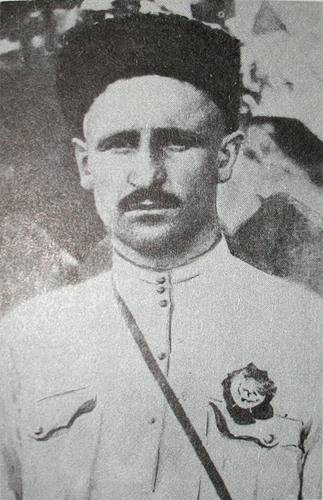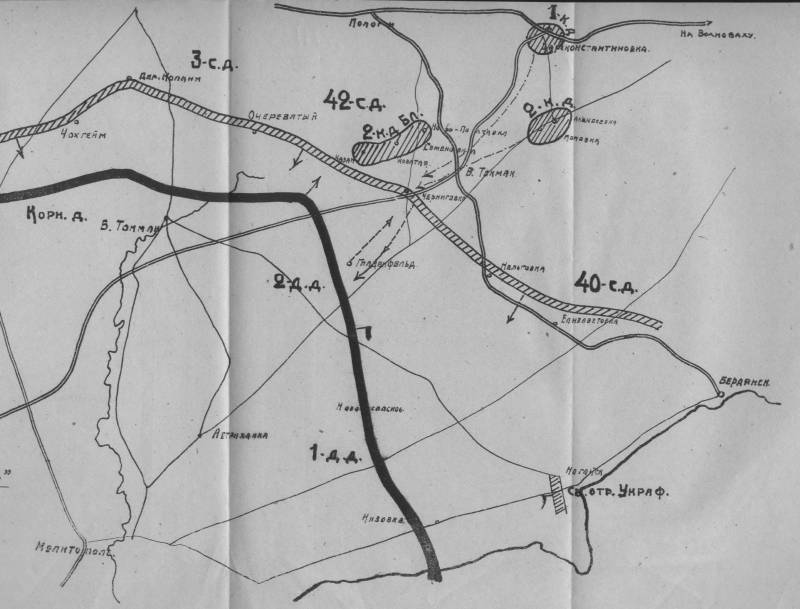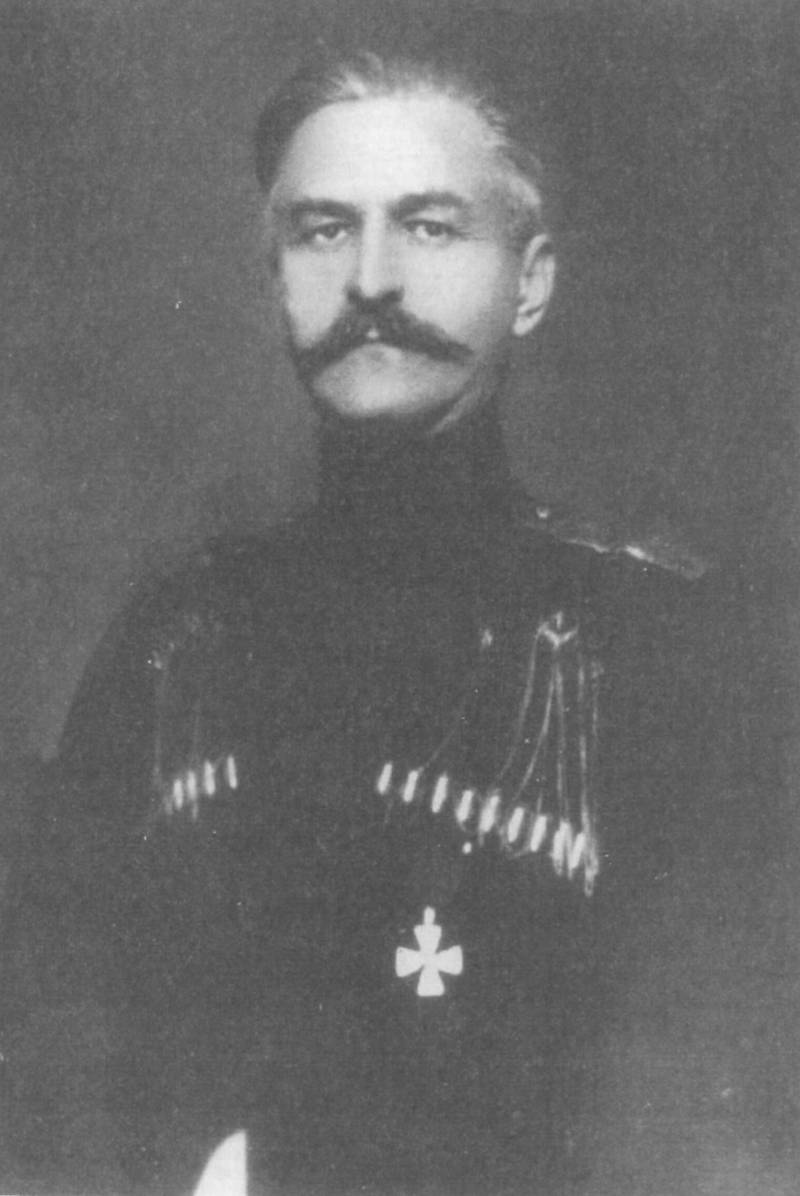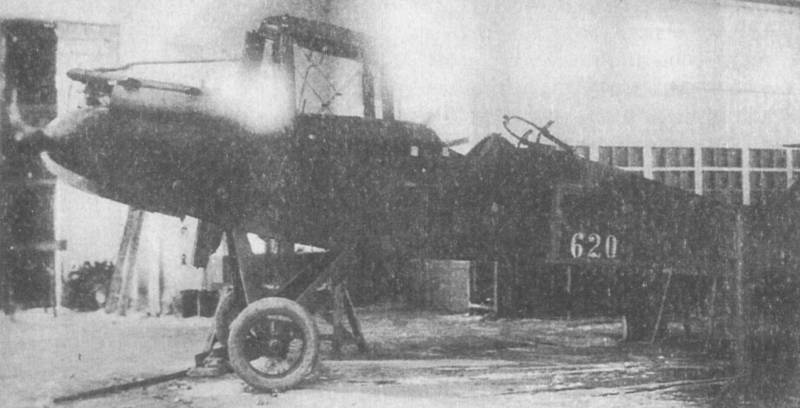Aviation against cavalry, or raid on Melitopol
It was planned to create a troop group consisting of three cavalry divisions (cavalry corps), the 40 th rifle division, and the consolidated detachment of the Upraform 1 th Cavalry Army after concentrating the Corps of the Goat. The task of this, in fact, army group is to knock down the Don Corps from positions and carry out an equestrian raid on the city of Melitopol — to the rear of the Russian Army (including to blow up the railway of Sevastopol-Aleksandrovsk).
If successful (and this, judging by the fighting past of the Goblet Corps, the Soviet command could count), the front command planned to force P. N. Wrangel's troops to withdraw to Perekop.
27 June was given an operational order, which the Redneck Group was instructed to crush the Don Corps, seize Melitopol and blow up the railway to the south of the city.
But the command was in a hurry with the execution of this order, and by the time of its implementation the corps did not have time to fully concentrate and establish contact with other units of the military group. And this was the case at a time when the hull control was already not up to par. The staff work in the corps and divisional headquarters was not properly organized, the use of technical communications was not customary for the command of the formation. Orders were written, albeit briefly, but not clear. Soviet sources [for example, Babel I. E. Works. T. 1. M., 1990] noted the disastrous shortcoming inherent not only to the Corps of the Goat, but also to the rest of the cavalry (and not only the red) of the Civil War era - it was prone to attacking the rear lines and transports of the enemy. This gave rise to the desire for robbery - and to the detriment of a military operation. This sin more than significantly affected the fate of the operation in question.
Artillery was not held in high esteem, and it was used little in the corps. But, on the other hand, thanks to the personal inclination of D.P. Zhloba to motoring, his corps was “pulled” by joint actions with armored vehicles, which played the role of intelligence officers in the compound.
Due to the shortage of horses (it was planned to replenish with a horse force during the offensive) the 3, 5 and 6 cavalry regiments were dismounted. But dismounted cavalrymen looked at themselves as cavalry and infantry service carried lightly.
The Achilles heel of the corps was also its wagon train: not only the command personnel, but also many Red Army men had several clockwork horses at the carts. This heavily burdened the rear. Moreover, the wagon train was modular: it included wagons, packs, carts and even camels. Incidentally, it was the first camels racing around the field that were the first to report the failure of the operation.
In the afternoon of June 28, the corps headquarters received an order from the command of the 13 Army to immediately launch an offensive. The group was still not ready for it: not all the units managed to concentrate, they did not establish contact with them - and by the beginning of the operation, the corps headquarters could not find the Blinov 2 Cavalry Division - and the division was not given the appropriate order.
But the offensive began.
Il 1. The position of the forces of the parties during the raid on Melitopol.
2 th cavalry division was ordered to move to the village. Upper-Tokmak, and 1 of the cavalry division - along the railway Tsarekonstantinovka - Upper Tokmak.
The 2 Cavalry Division clashed with parts of the white 7 Infantry Regiment, which, with the support of the Gundor Georgievsky Regiment, began a stubborn battle, very soon turned into a hand-to-hand fighting. As a result of a fierce battle, the red cavalry took about 300 prisoners.
The first success greatly raised the morale of the cavalry corps.
The 2 Cavalry Division named after Blinov was also discovered. On June 29, at Gnadenfeld, she also joined the battle.
During this battle, the influence of white aviation - a large squadron (13 De Haviland airplanes), under the personal command of the Chief of Aviation of the Russian Army, Major General V. M. Tkachev attacked both advanced red divisions and bombarded them. Unaccustomed to rapid tactical rebuilding, the 1st Cavalry Division and the 2nd Cavalry Division named after Blinov are knocked together and become a victim of aviators. Divisions lost up to 500 horses.
I. 2. Major General V. M. Tkachev. Photos 1930's
Il 3. "De Heviland 9" № 620, in which V. M. Tkachev personally led the assault attack on the cavalry Zhloba.
On this day Horsemen Goons were only 15 versts.
The next two days, June 30 and July 1, were lost - the hull did not move, fearing to undergo a new air strike. There was no contact with the white parts.
After receiving a reminder from the army headquarters on the movement to Melitopol, the commander of July 1 issued order No. 445 indicating the purpose of the offensive.
It was decided to move exclusively at night.
And during the night from 1 to July 2, the corps moved forward. The 2 Cavalry Division struck up a battle at Prangenau and Lichtefeld. The remaining compounds also fought local battles.
Due to the slow pace of the Reds' movement, the white command managed to transfer part of the forces of the Kornilov shock division and the detachment of General Anguladze to the threatened front sector.
Appeared in the 10 hours of July 2 on the north-eastern edge of the village. Lichtefeld 2 armored car, as well as the fire of white artillery led to panic in parts of the 2 th cavalry division. This demoralization has begun. Coming up on a hill between Lichtefeld and Rickenau, the division attacked the white infantry.
The 1 Cavalry Division at heights north of Lichtfeld was met with artillery fire and a white counterattack. And also got into a mess.
Finally, the 2-I Blinov Cavalry Division also rushed in a northwesterly direction.
It was a turning point of the operation.
It should be noted here that if the infantry is relatively easy to stop the panic, since the infantryman will not run away far, then it is difficult to keep up with the cavalry infected by the cavalry. In this situation, it is very important to immediately take the reins of control in firm hands - and just control in the cavalry corps of the Redneck was not up to par, and in a more favorable environment.
Breaking between Tigerweide and Rickenau, parts of the cavalry corps carried to the heights north-west of Rickenau. Here they were shelled by field artillery fire and two armored trains, and grouped by beams. Attempts by the command to adjust the management of parts of the corps were unsuccessful.
Trying to break through the white armored trains, a large part of the Raze’s corps was shot by artillery fire and, having thrown carts and guns, broke through, but with heavy losses.
Moreover, part of the cavalry mixed with white carts, and, carried away by robbery, crowded them, forming a compact and homogeneous mass that armored trains even stopped fire, fearing to hit their own.
At this time, the squadron of the Russian army reappeared, which, having fallen, shot point-blank cavalrymen.
The main reasons for the defeat of the Corps Corps were as follows.
1) Poor connection management. Despite the fact that, in the North Caucasus, D. P. Zhloba proved himself to be a brave and experienced cavalry commander, in Northern Tavria he was not up to par, completely letting go of the entrusted command from his hands.

Il 4. D. P. Zhloba.
2) Despite the fact that the backbone of the group advancing on Melitopol was cavalry, its tactical independence was not ensured - the cavalry was subordinated to the infantry combat sector, and the 40 Infantry Division and the Upraform 1 Group of the Cavalry Army in combat did not accepted.
3) The presence of a convoy, strongly constrained the movement of the body.
4) Very cautious actions of cavalry, ineptly using the guns and machine guns in its combat formations.
5) Perhaps the most important reason is the brilliant actions of the Russian Army aviation. They had not only tactical, but also operational value. Aviation did not just bring down the pace of the advance of the cavalry unit - it presented to its general military command two whole days of operational time.
Thus ended the unsuccessful raid on Melitopol, on which the Soviet command had placed such high hopes. Perhaps the Soviet military specialists were right, noting that if the operation was successful, not only the Wrangel front could be eliminated on 2-3 a month earlier, but the confrontation with Poland had a more positive end result.



Information